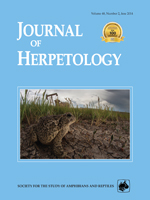The genus Phymaturus, entirely viviparous and mostly herbivorous, inhabits the cold and harsh environments of the Andean highlands of Argentina and Chile, and the Patagonian steppe of Argentina. Phymaturus punae is a vulnerable lizard endemic to the Biosphere Reserve San Guillermo (National Park and Provincial Reserve) in San Juan (Argentina) that inhabits high altitudes of 3,100–4,200 m. The reproductive cycles of males and females of P. punae have been described previously. Males perform a prenuptial and annual cycle of spermatogenesis, and females reproduce once every 2 yr. As a consequence, the adjustment in the timing of males to the reproductive cycles of females must be very precise to ensure reproductive success. We elucidate the time of mating and the asynchrony of male and female reproductive events in P. punae based on endocrine and ultrastructural studies. Present hormonal results support the idea that copulation in P. punae occurs at the end of the activity season. Ultrastructural features observed in Sertoli and Leydig cells indicate that both types of cells have the potential to synthesize steroid hormones, to support the spermatogenic cycle and the mating period, respectively. In P. punae the cases of temporal asynchrony in steroid activity suggest that this mechanism must be important to start the spermatogenesis in spring, supported by the steroid activity of Sertoli cells, as Leydig cells are inactive. Nevertheless the asynchronic steroid mechanism seems to be more necessary in Phymaturus species with continuous or postnuptial cycles than in species with prenuptial cycles, like P. punae.
El género Phymaturus, enteramente vivíparo y mayormente herbívoro, habita ambientes fríos y rigurosos de la Cordillera de los Andes en Argentina y Chile, y de la estepa Patagónica Argentina. Phymaturus punae es un lagarto vulnerable, endémico de la Reserva de la Biósfera San Guillermo (Parque Nacional y Reserva Provincial) en San Juan (Argentina), que habita a altas altitudes entre los 3.100 y 4.200 metros. Los ciclos reproductivos masculinos y femeninos de P. punae fueron descriptos. Los machos realizan un ciclo espermatogénico anual prenupcial, y las hembras se reproducen una vez cada dos años. En consecuencia, el ajuste de los tiempos de los machos al ciclo reproductivo femenino debe ser muy preciso para asegurar los sucesos reproductivos. Dilucidamos el período de cópula y la asincronía de los eventos reproductivos de machos y hembras de P. punae, en base a estudios endócrinos y ultraestructurales. Los resultados hormonales obtenidos apoyan la idea que la cópula en P. punae ocurre al final de la temporada de actividad. Las observaciones ultraestructurales en células de Sertoli y de Leydig indican que ambos tipos celulares tienen el potencial para sintetizar hormonas esteroideas, para mantener la espermatogénesis y la cópula, respectivamente. En P. punae los casos de asincronía temporal en la actividad esteroidea, sugieren que este mecanismo es importante para iniciar la espermatogénesis en primavera, sostenida por la actividad esteroidea de las células de Sertoli, mientras las células de Leydig están inactivas. No obstante, el mecanismo de asincronía esteroidea parece ser más necesario en especies de Phymaturus con ciclos continuos o postnupciales, que en especies con ciclos prenupciales, como P. punae.





